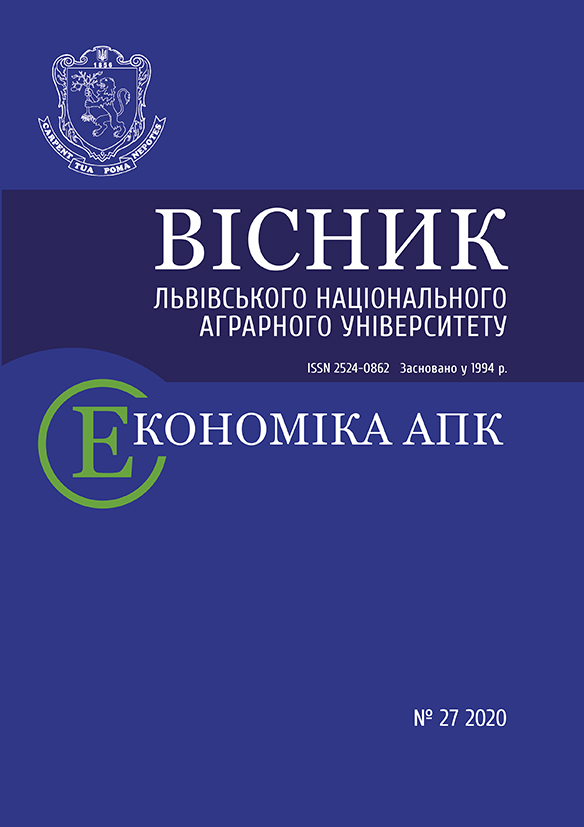Visnyk LNAU: Agronomy 2021 №25: 30-34
PROCESSES OF SELF-PURIFICATION UNDER THE INFLUENCE OF TERRITORY URBANIZATION ON THE FOOTHILLS AND PLAIN AREAS OF THE STRYI RIVER
Snitynskyi V., Doctor of Biological Sciences
ORCID ID: 0000-0001-9633-1004
Khirivskyi P., Candidate of Biological Sciences
ORCID ID: 0000-0001-7246-9260
Hnativ I., PhD student
ORCID ID: 0000-0002-2987-1673
Lviv National Agrarian University
https://doi.org/10.31734/agronomy2021.01.030
Annotation
Based on the analysis of scientific publications, it was found that population growth, industrial production and urbanization have caused more intense anthropogenic pressure on water bodies. The decrease in surface water quality in the river basins of Ukraine is caused by the discharge of insufficiently treated wastewater by industrial enterprises with different content of organic, bacterial and chemical pollutants. These substances affect the organoleptic properties of water in rivers and biochemical processes, slowing down or completely suppressing the natural process of self-purification. Annually, about 9.6 billion m3 of insufficiently treated wastewater is discharged into the basins of our rivers, of which 2.9–4.0 billion m3 is polluted.
Today, there is pollution of both natural and anthropogenic nature in the rivers. The natural chemical composition and properties of surface water are formed depending on hydrological, soil, climatic and other features. Landfills of household solid waste, flushing of fertilizers and pesticides from fields, stormwater runoff from urban and industrial areas, precipitation polluted by harmful emissions, a growing number of recreational areas, etc. have a negative impact on the surface and groundwater.
Given the significant amount of wastewater discharges by existing industrial enterprises and their insufficient treatment at the treatment facilities in Stryi and Skole, it is possible to predict a significant impact of these urban areas on river water quality. The aim of the work is to assess the impact of urbanization of Stryi district of Lviv region on the processes of self-cleaning of the Stryi River. The results of laboratory research on the sanitary-chemical indicators are used in the work. An assessment of the ecological and hygienic conditions of the river water quality of the rivers of Stryi and Opir and determination of the composition of pollution caused by the impact of the urban area are provided.
Key words
urbanized areas, anthropogenic impact, water quality indicators, water bodies
Link
- Aleksevnina M. S., Pozdeev I. V. Sanitary hydrobiology with the basics of water toxicology: studies. manual. Perm, 2016. 205 p.
- Environmental safety of the region’s hydrosphere, sewage treatment and utilization of water purification sludge / O. M. Adamenko et al. Ecotekhnology and Resource Conservation. 2007. № 5. P. 68–73.
- Hryniuk V. I. Investigation of the processes of self-cleaning of the right inflexes of the river candle basin of the Dniester. Scientific Bulletin of the NLTU of Ukraine. 2018. Vol. 28, № 3. P. 77–82.
- Karpets K. M. Design factor relief-dependence self-cleaning permanent watercourses city of Kharkov. Man and the environment. Problems of neoecology. 2014. № 3–4. P. 52–56.
- Korchemliuk M. V., Arkhypova L. M. Estimation of key pressures on the Prut River basin in Ukraine. Ecological safety. 2015. Vol. 1. P. 41–45. URL: http://nbuv.gov.ua/UJRN/ekbez_2015_1_10 (Last accessed: 29.03.2021).
- Oshurkevich-Pinkovskaya O. E., Pankovskyi Yu. I. Methods for determining the calculated flow of water in aqueous objects in calculating the maximum permissible discharge of pollutants with reverse waters. Scientific Bulletin of the NLTU of Ukraine. 2016. Vol. 26.8. P. 205–210.
- Salla M. R. Importance of calibration for mathematical modeling of self-purification of lotic environments. Acta Limnol. Bras. 2016. Vol. 28. Rio Claro 2016 Epub Dec 19, 2016.
- Self-cleaning of the Dnipro Reservoir as a leading factor in the formation of an environmentally safe habitat of fish / A. I. Dvoretskyi et. al. Fish Science of Ukraine. 2014. № 4. Р. 26–36.
- Snitynskyі V. V., Hnativ P. S., Lopotych N. Y. Environmental safety and protection of the environment Eastern Beskids: Monograph. Lviv: Kamula, 2018. 180 p.
- Snitynskyі V. V., Khirivskyi P. R., Hnativ I. R. Influence of the urbanized territory of Stryi on the quality of the River water. // Journal of Lviv National Agrarian University: agronomy. 2020. № 24. P. 17–22.
- Spitsina T. P., Taseiko O. V. Complex criteria self-cleaning of watercourses. Bulletin of TSU. Series «Biology and Ecology». 2018. № 2. P. 248–262.
- Zaharia Ca. Decentralized wastewater treatment systems: Efficiency and its estimated impact against onsite natural water pollution status. A Romanian case study. Process Safety and Environmental Protection. 2017. Vol. 108. P. 74–88.



